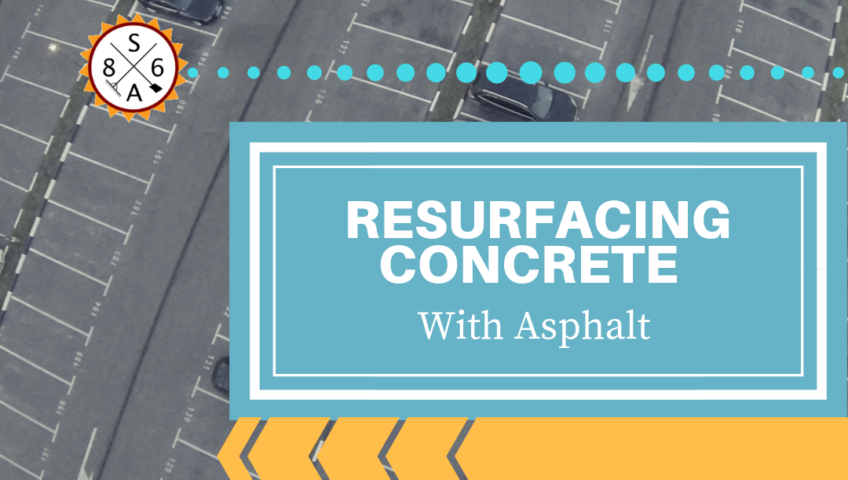
Resurfacing Concrete With Asphalt
Concrete is an inexpensive building material that shows up in a number of domestic and commercial applications. It is often used for floors, driveways, sidewalks, and even parking lots. However, concrete has limitations. These problems may show up over time or as the concrete weathers:
- Unsightly staining. This can range from mold to spilled garage chemicals to simple weathering that gives it a dull look.
- Cracks. These may start from impacts, extreme temperatures, or water. They can start out small but, if not addressed, will spread and worsen.
- Surface pitting. This kind of damage, which may come from sources like weather or chemical contact, makes the concrete vulnerable to cracking. It is also unsightly.
- Potholes. These can develop and worsen during use.
- Bulges. They may appear after a winter and hint at potential water damage. Bulges also stress and weaken the concrete in these areas.
- Erosion. If you see erosion in the earth under the edges of the concrete, this is a sure sign of water flowing down there.
What can you do if you notice these issues? Can you prevent trouble before it develops? In both cases, you may want to resurface your concrete with asphalt.
What is Asphalt Resurfacing?
Asphalt resurfacing involves placing a solid layer of asphalt over the existing concrete. It does not involve removing the concrete or randomly patching problems. Resurfacing creates a smooth surface that is pedestrian and vehicle friendly. It also does not allow water to seep in and cause damage.
What Are the Advantages of Asphalt?
Asphalt has a number of advantages over concrete. These include:
- Price. Asphalt is often a more budget-friendly solution than pouring new concrete. It may be half the price or less.
- Durability. Due to how it’s made, asphalt tends to hold up better to harsh weather. If you live in an area with intense winters, asphalt may be the better choice.
- Easy maintenance. Asphalt is easy to remove snow and ice from. It holds up better to road salting. Snow and ice melt faster on this heat-retaining surface. Finally, due to the color, it does not show stains as much.
- Easy repair. When concrete gets damaged, you will typically need to replace or resurface it. Meanwhile, asphalt can be directly repaired. The material bonds well to patches and new areas. This makes it easy to repair cracks and other damage.
- Quick installation. Asphalt has a noticeably quicker time for installation, making it a great fit for businesses that don’t want to shut down for very long.
- Repaving is easy. Because asphalt is made of a number of layers, it is straightforward to remove and replace just the surface.
Take it To the Pros
When it comes to surfaces you walk and drive on, you want to make sure it gets done right the first time around. It’s vital to create a smooth surface that won’t harm tires or cause people to trip. Large areas like parking lots may require banking so water drains properly. It’s also important that the surface creates a seal, keeping water out. Water can cause a lot of damage, especially during freezing winters.
This is why it’s essential to hire experienced professionals. The right company can evaluate what your home or business needs. They’ll give you a quote and get the job done quickly.
Concrete is an inexpensive building material that shows up in a number of domestic and commercial applications. It is often used for floors, driveways, sidewalks, and even parking lots. However, concrete has limitations. These problems may show up over time or as the concrete weathers:
- Unsightly staining. This can range from mold to spilled garage chemicals to simple weathering that gives it a dull look.
- Cracks. These may start from impacts, extreme temperatures, or water. They can start out small but, if not addressed, will spread and worsen.
- Surface pitting. This kind of damage, which may come from sources like weather or chemical contact, makes the concrete vulnerable to cracking. It is also unsightly.
- Potholes. These can develop and worsen during use.
- Bulges. They may appear after a winter and hint at potential water damage. Bulges also stress and weaken the concrete in these areas.
- Erosion. If you see erosion in the earth under the edges of the concrete, this is a sure sign of water flowing down there.
What can you do if you notice these issues? Can you prevent trouble before it develops? In both cases, you may want to resurface your concrete with asphalt.
What is Asphalt Resurfacing?
Asphalt resurfacing involves placing a solid layer of asphalt over the existing concrete. It does not involve removing the concrete or randomly patching problems. Resurfacing creates a smooth surface that is pedestrian and vehicle friendly. It also does not allow water to seep in and cause damage.
What Are the Advantages of Asphalt?
Asphalt has a number of advantages over concrete. These include:
- Price. Asphalt is often a more budget-friendly solution than pouring new concrete. It may be half the price or less.
- Durability. Due to how it’s made, asphalt tends to hold up better to harsh weather. If you live in an area with intense winters, asphalt may be the better choice.
- Easy maintenance. Asphalt is easy to remove snow and ice from. It holds up better to road salting. Snow and ice melt faster on this heat-retaining surface. Finally, due to the color, it does not show stains as much.
- Easy repair. When concrete gets damaged, you will typically need to replace or resurface it. Meanwhile, asphalt can be directly repaired. The material bonds well to patches and new areas. This makes it easy to repair cracks and other damage.
- Quick installation. Asphalt has a noticeably quicker time for installation, making it a great fit for businesses that don’t want to shut down for very long.
- Repaving is easy. Because asphalt is made of a number of layers, it is straightforward to remove and replace just the surface.
Take it To the Pros
When it comes to surfaces you walk and drive on, you want to make sure it gets done right the first time around. It’s vital to create a smooth surface that won’t harm tires or cause people to trip. Large areas like parking lots may require banking so water drains properly. It’s also important that the surface creates a seal, keeping water out. Water can cause a lot of damage, especially during freezing winters.
This is why it’s essential to hire experienced professionals. The right company can evaluate what your home or business needs. They’ll give you a quote and get the job done quickly.




